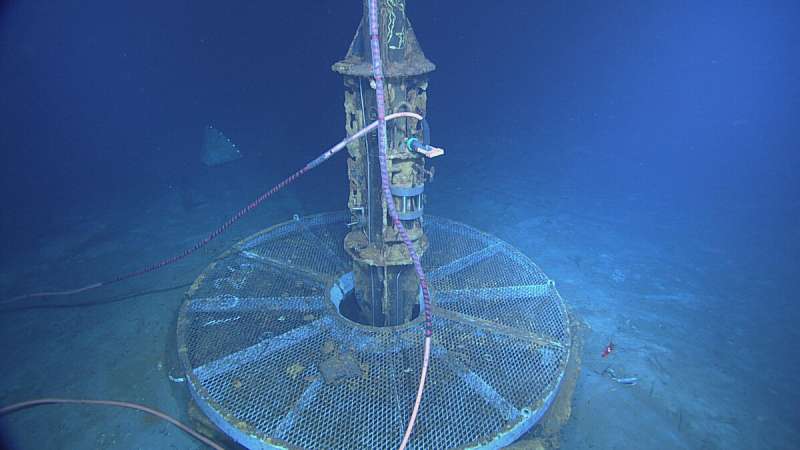The CORK (Circulation Obviation Retrofit Kit) borehole monitoring observatory, pictured here, is connected to the Ocean Networks Neptune Canada cable system. It can monitor fluid pressure within the oceanic crust that contains faults and fractures as pathways for water, heat, and chemical exchange between rock and ocean. Credit: Ocean Networks Canada
The natural structure of the rigid oceanic crust that forms a shell around Earth contains cracks and faults. These fissures are hydrothermal pathways for heat, water, and chemical solutions to move between the ocean and the lithosphere.
Scientists traditionally use seismic waves to uncover the nature of oceanic crust, including lithology and structure. When seismic compressional waves, or P waves, travel along fault trends, the wave speed remains largely unaffected. In comparison, previous research has discovered that seismic velocities can be up to 20% slower when waves pass across local faults and fractures compared to when they cross less fractured crust. Additionally, prior work has used remote seismic detection to map out the large-scale seismic speeds of oceanic crust.
In a new study by Sun et al., the researchers characterized formation-scale mechanical properties using direct, in situ measurements of fluid pressure and colocated seismic records. They used an array of boreholes and seafloor instruments connected to Ocean Networks Canada's cabled NEPTUNE observatory that spreads across the Juan de Fuca and North American plates. To understand how compressible the crust is, the team compared seismic surface wave strain with formation fluid pressure variations caused by distant large earthquakes. Although the use of formation fluid pressure as a proxy for strain has been applied to other settings, this study is the first to use the approach at seismic frequencies in an offshore setting.
The researchers found that in the faulted oceanic crust, their compressibility determinations indicated that seismic waves traveling in the cross-fabric direction would be slowed by more than 50%. This slowing is much more dramatic than all previous standard seismic measurements and suggests that there may be ubiquitous—and previously unrecognized—fracturing in the upper hundreds of meters of oceanic crust.
Their results indicate that the degree of fracturing of shallow oceanic crust is substantial and has direct influence on hydrothermal circulation and slab hydration. The age of the crust where this study was carried out is 3.6 million years old, and the authors hope new offshore borehole monitoring in other locations will better define the nature of faulting and the crust's hydrologic properties.
More information: Tianhaozhe Sun et al, Seismic Formation Fluid Pressure Observations Reveal High Anisotropy of Oceanic Crust, Geophysical Research Letters (2021). DOI: 10.1029/2021GL095347
Journal information: Geophysical Research Letters
Provided by Eos
























